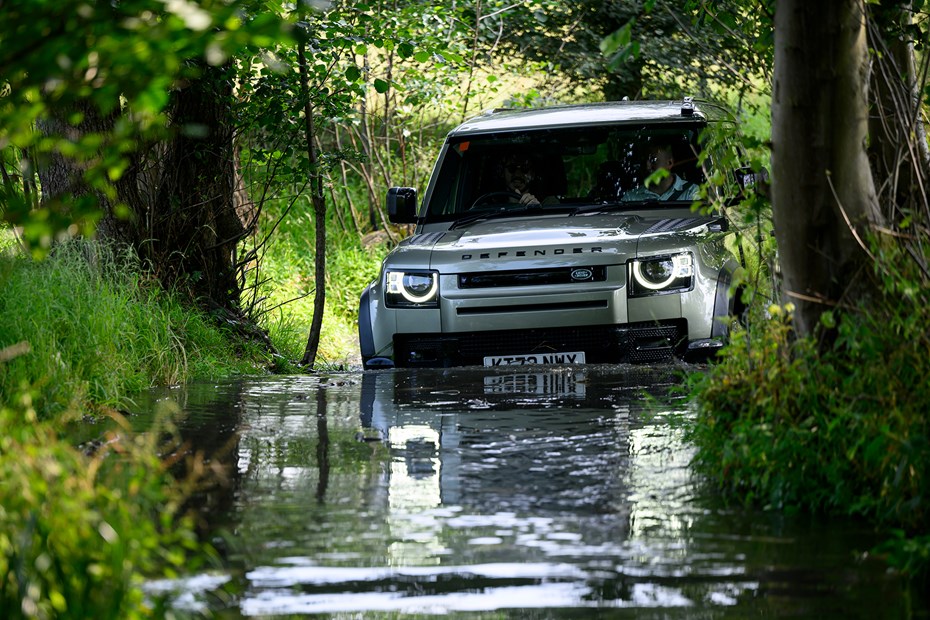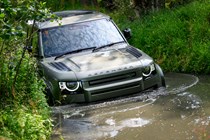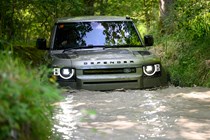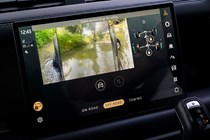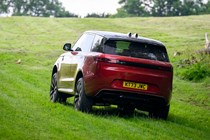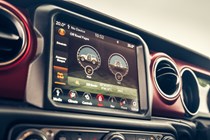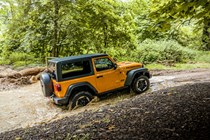SUVs are hugely popular right now. Over the past decade, car makers have been steadily purging their model ranges of saloons and hatchbacks and replacing them with tall-riding, tough-looking crossovers. Don’t be fooled by their butch exteriors, though – most of these family-friendly SUVs are front-wheel drive and almost entirely road biased, which means they’ll struggle with serious off-road driving.
If you want to tackle anything tougher than the gravel car park at your local farm shop, we suggest you buy a purpose built 4x4 such as a Land Rover Defender or a Toyota Land Cruiser. Then, once you have the right tool for the job, you need to learn how to use it properly – and that’s where Parkers comes in.
Driving off-road is more complicated than aiming your car at the rough stuff and hoping for a good result. In this guide, we’ll teach you how to get the best from your off roader, providing pointers on proper off-road driving technique, choosing the correct tyres for the conditions and taking advantage of your car’s technology.
Get to know your off roader
The key to not getting stuck off-road is to understand your car’s capabilities and work within them. Below, we’ve listed the five key pieces of info you should research about your car before heading out into the wilderness:
- Ground clearance: The amount of distance between your car’s bodywork and the floor. It dictates the size of obstacle you can climb on level ground.
- Approach angle: The gradient your car can drive up without its front bumper running into the ground before your tyres touch the slope.
- Departure angle: The gradient your car can drive down without its rear bumper catching on the ground when you’re leaving the slope.
- Breakover angle: The maximum height of peak your car can summit without getting stuck like a seesaw.
- Wading depth: The maximum depth of water your car can drive through without floating or risking damage to the engine.
A good way to learn the limits of your car is to test is its capabilities in a safe environment before heading out into the wilderness. That could be a steep gradient near a stretch of level ground that you can creep up to and gauge your approach, departure and breakover angles without fear of getting stuck. That way, when you encounter the same obstacle in the bush, you know to avoid it.
Know the rules of the countryside
Swot up on the Countryside Code before you leave to make sure you’re not driving somewhere you’re not allowed to. Official byways are signalled by coloured arrows – and those marked with a red arrow are open to all traffic, including motorised vehicles.
Don’t drive down any other route signalled by coloured arrows, as they may not be wide enough for your vehicle – and you will risk endangering pedestrians and horses.
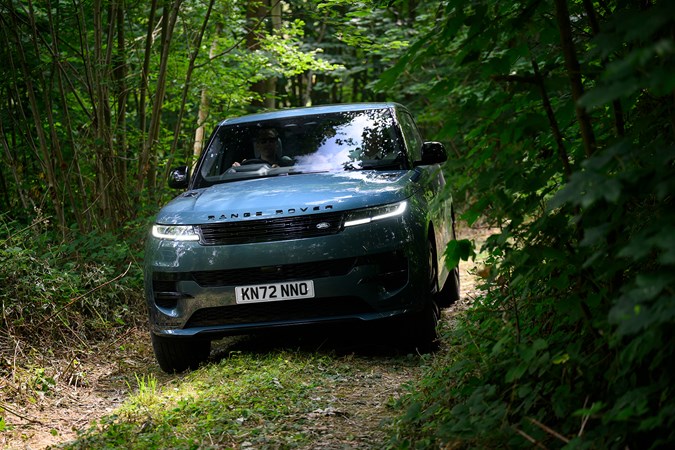
If you’re unsure about where you’re allowed to drive, buy an up-to-date, paper Ordnance Survey map and look for routes marked with little crosses. These are byways open to all traffic and – generally – you will be allowed to drive your car down them.
Tracks signalled by red arrows are open to all traffic, including motorised vehicles. Don’t drive your off roader down any other route signalled by coloured arrows, as they may not be wide enough for your vehicle – and you could risk endangering pedestrians.
Be prepared to get stuck
Getting stuck is part of off-roading – and your level of preparation separates the amateurs from the professionals. At the very least, always carry a tow rope, some water and a mobile phone with you. That way, you can call for a friend to come and rescue you if you beach your car, and you won’t die of dehydration before they arrive.
It’s also a good idea to take some food, some warm clothes and some sturdy footwear. Take a change of clothes with you, too, just in case you fall into the mud up to your armpits while trying to rescue your car from a cloying bog hole.
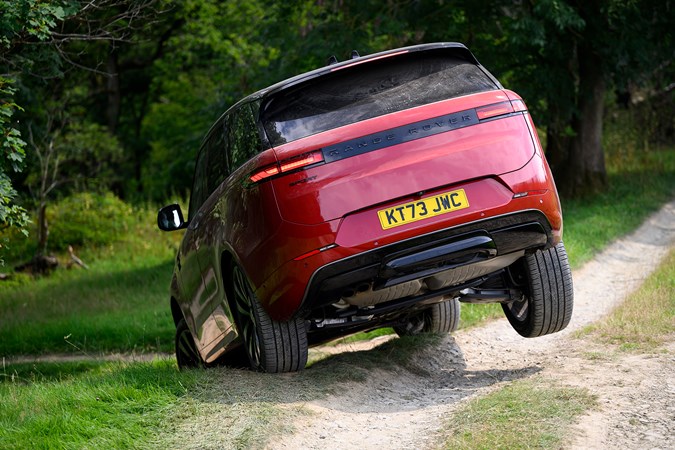
If you’re planning to take your off-roading very seriously, we’d recommend investing in a winch. These motorised towropes attach to your car’s front bumper – and they allow you to rescue yourself from a mud pit. You anchor them to a nearby tree and use the motor to haul your car back to safety.
Choose the correct tyres for the terrain
Most off-roaders are fitted with all-season tyres from the factory, as they offer the best compromise between on- and off-road driving. They won’t impact your car’s cornering ability and stopping distance on the road, and they’re quiet enough to not deafen you on the motorway, but they have just enough tread depth for some light off-roading.
If you plan on doing some serious mud-plugging, you need to step up to a set of dedicated off-road tyres. These have more aggressive treads than road tyres, which allows them to better bite into the terrain and keep your car moving on loose surfaces.
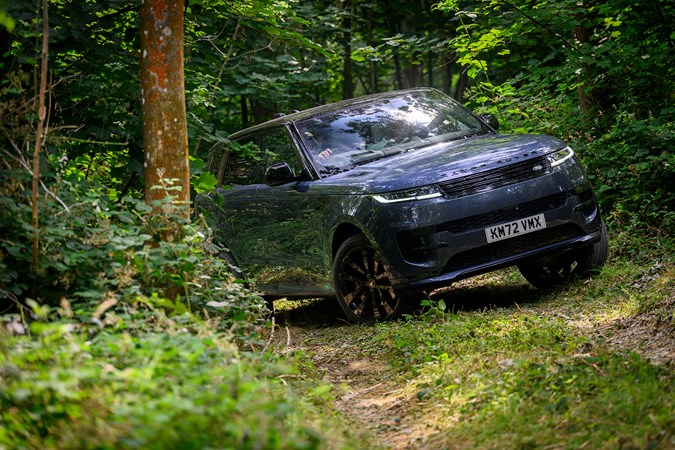
However, because they’re so much more aggressive, they generate a lot more road noise which will make your car less comfortable on Tarmac. Depending on how aggressive you go, your car’s on-road performance might also be affected.
There are two main categories of off-road tyre. All-terrain tyres are like a more rugged version of all-season tyres. They’re still suitable for road use, but they have far knobblier treads which afford you some extra grip on loose surfaces.
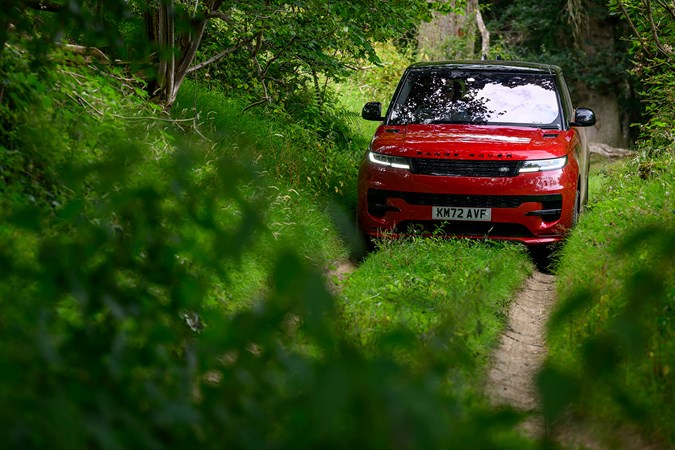
Mud-terrain tyres are designed for serious off-roading. They have even more aggressive treads that stretch further around the tyre’s sidewall, which makes them better able to claw through rocks, sand and thick mud.
However, these knobblier treads mean less of your tyre is in contact with the road. That means your cornering ability and stopping distances will be impacted. For that reason, we don’t recommend you use mud-terrain tyres of everyday driving.
Apply the correct driving techniques
Driving off road requires you to recalibrate your driving style. For starters, you should always keep your thumbs outside of the steering wheel, just in case you hit a sharp bump. In some cases, the jolt can be severe enough to whip the wheel around and break the bone in your hand. That’ll make for a very painful drive home.
Be gentle with the throttle – for two reasons. By taking it easy, you’re less likely to hit any obstacles at speed, which means you’re less likely to damage your car. Plus, high wheel speed isn’t generally preferred on surfaces such as mud and snow. You’ll only end up digging your tyres into the surface and getting stuck.

Use your diff-locks and low-range transfer case (if you have those fitted). The first piece of equipment locks the rotation of your wheels together, which means more of your engine’s power is being used to drive the car forward. The second engages an ultra-low crawler gear that increases the amount of torque (pulling power) acting on your wheels, giving you a mechanical advantage over sticky or rocky terrain.
When going uphill, always use the highest gear possible and, when going down, make it the lowest one. If you’re driving an automatic, take manual control of the gears if you can and always remember that progress is a combination of being able to manage momentum, traction and speed. Be careful, be decisive and always plan ahead. And remember, if you’re unsure of the terrain, ask a friend to guide you through it from outside the vehicle.
Use your car’s technology
Many 4x4s, including recent pickups and all new Land Rovers, have a Hill Descent Control (HDC) system (or something like it). This allows the car to use its brakes and transmission to allow you to descend a slope at a safe speed of your choice. Use it.
Land Rover has taken this technology a step further. It’s launched a new Adaptive Off-Road Cruise Control system which will automatically keep the car moving at a set speed of up to 20mph over rough terrain. It analyses the car’s angle, suspension articulation and wheel slip to decide how quickly the car should be moving.

On hardcore 4x4s such as Land Rovers and Jeeps, you can set the screen to show various bits of off-road data. This includes the angle of your car, what your four-wheel drive system is doing and even steering angle. This latter point might seem trivial but, when you’re up to your wheelarches in mud, it’s easy for a hard-working driver to lose track of where the front wheels are pointing.
We’d also recommend getting familiar with your car’s camera system (where fitted). Surround view cameras can help you navigate through tight obstacles such as trees and boulders, while dedicated off-road system such as those found in Land Rovers can even allow you to see ‘through’ the bonnet by relaying an image of what’s under your front wheels into the cabin. This makes cresting a steep hill a far less daunting experience.
Dealing with different terrain
Driving on gravel
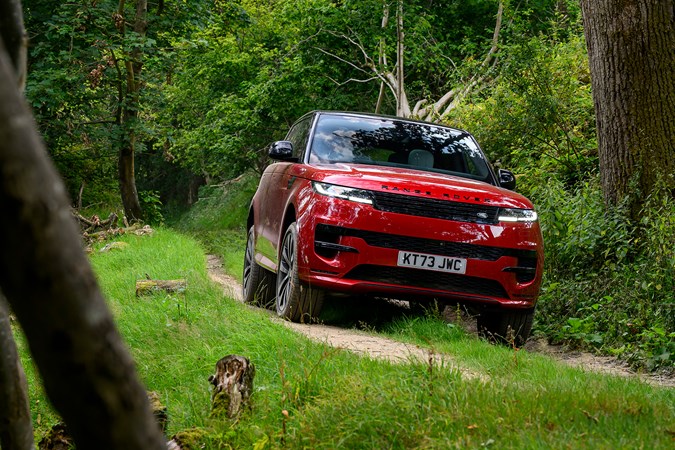
If you’ve only ever driven on Tarmac, you’ll find driving on gravel quite challenging because the amount of available traction is constantly changing. Accelerate more gently than you would on the road and take a wide arc when cornering to prevent the front wheels from digging into the surface and pushing straight on.
Don’t be afraid of a little wheelspin, though. Modern four-wheel drive systems work in conjunction with the car’s traction and stability control systems to apportion power to whichever wheel or wheels has the most grip. Although we wouldn’t recommend just stamping on the throttle everywhere, these systems do often need to register some slip before they can work, so make sure to work with wheelspin when the conditions allow.
Driving on snow and ice
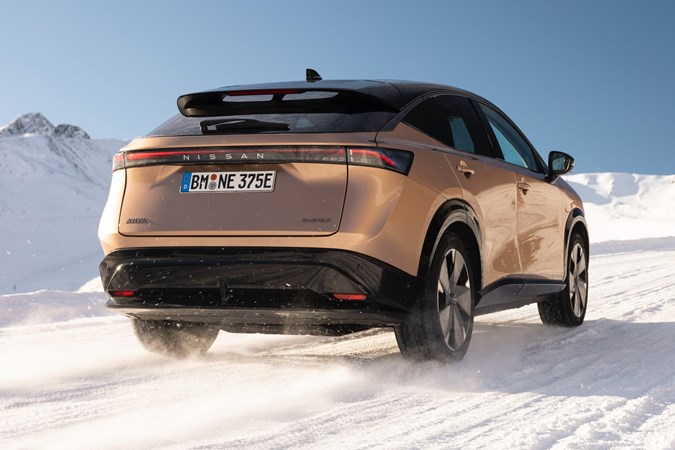
We’ve already produced a general guide to driving on snow, but we’ll summarise the main points here. Use the highest gear possible to prevent wheelspin and maintain momentum, as setting off on snow is tricky due to the lack of traction.
Stopping on snow is difficult for the same reason, but you can improve your chances by fitting a set of winter tyres. If you’re driving on ice, you’ll see an even greater improvement by opting for studded tyres. In any case, if you’re in a convoy, leave plenty of distance between you and the car ahead.
Driving on grass
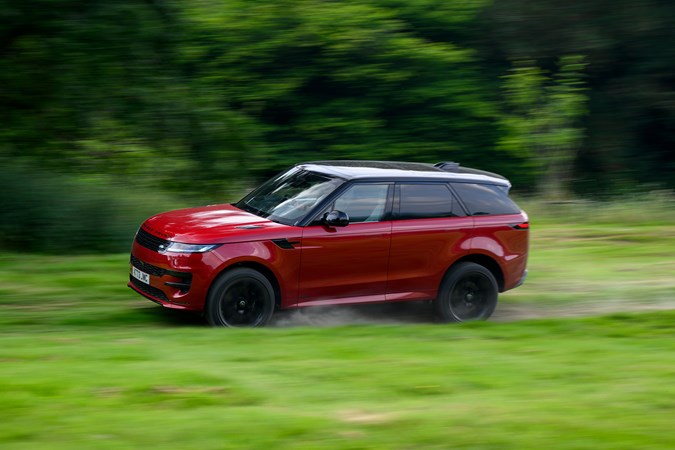
Grass – especially wet grass – behaves a lot like ice. In fact, our driving instructors at Land Rover’s Eastnor facility kept referring to grass as ‘green ice’ due to the similar amount of traction it offers.
One good tip is to never follow the vehicle ahead to avoid creating slick tracks and, much like gravel, remember to take the widest arc possible when changing direction.
Driving on sand
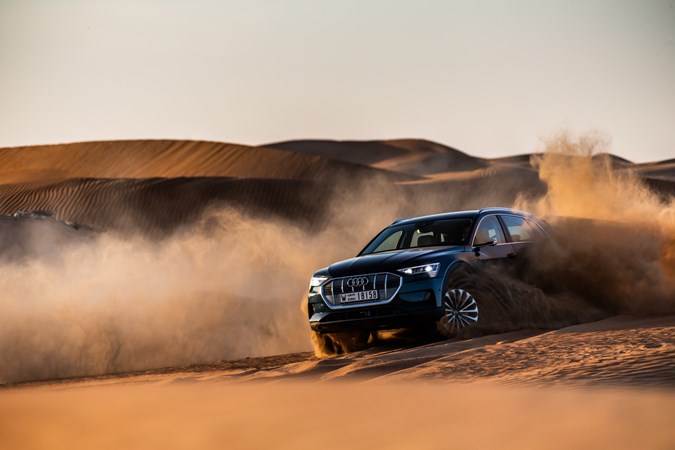
We’re going to sound rather contradictory here, but sand driving requires a more liberal throttle application. Driving in sand is all about maintaining momentum, so you need always have the wheels spinning to allow them to skip over the surface of the sand and keep the car moving.
You still need to be sensitive with the rest of the car’s controls, though. Don’t turn too sharply into corners, or else you’ll run the risk of digging the front end into the surface and getting stuck. Always look a long way ahead, too. Your inputs will take longer to register on sand, so give yourself as much time as possible to prepare.
Also, consider lowing your tyre pressures to 15psi. This will allow your tyres to spread out over the surface, giving you a wider contact patch and more traction. Remember to reinflate them to the correct pressure before you hit the road again. And, if you park up, leave your car on a downhill slope.
Driving on rocks

Before tackling a rock crawl, get out of your car and assess the risks – and if you have a passenger, get them to walk ahead of you. If you don’t, you could risk alloy wheel marks, a puncture or more serious damage to the underside of the car or bodywork.
To help prevent your car from leaning over too far, make sure you’ve even distributed any luggage you have on board – and pack it low-down in your car’s cabin to drop its centre of gravity. Engage low range, keep your car in a low gear and try to tackle any obstacles as directly as possible. The higher the angle, the higher the risk of tipping over.
If you have a more purposeful off-road vehicle, you may have the ability to disconnect its anti-roll bars to let the wheels on opposite sides reach the ground on very uneven surfaces. Selectable centre, front and rear differential locks will also keep the car moving forward even if one or two wheels are off the ground. Use them if you have them.
Driving on mud and ruts
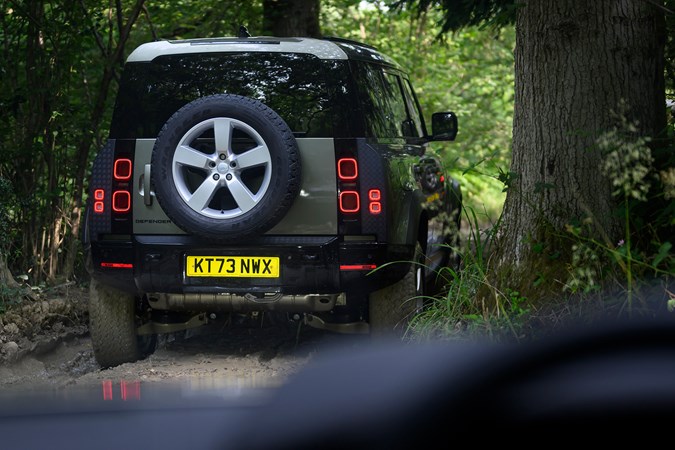
Mud and ruts are another challenging condition that demands precision and smoothness. To give yourself the best chance of success, always stay within the existing tracks and keep your wheels as straight as you can, as often as you can.
Make sure you keep your car’s lowest point clear of the hump in the middle of the rut – and drive as slowly as you can, while carting enough speed to maintain momentum.
Like all off-road driving, mud and ruts require reading the track ahead and planning your inputs accordingly. So, if you’re on an uphill incline, a touch of speed when approaching can overcome loose surfaces. Don’t be afraid to use more power to keep moving but try to avoid breaking traction – if your wheels are spinning, you’re more likely to dig yourself into a hole and get stuck.
If you can’t see what’s ahead, get out and inspect the surface before committing. Scan for rocks, large holes, tree stumps or any other obstacles that could cause damage to the underside of your car, so you can proceed with confidence.
Driving through water

The easiest way to tackle water is to avoid driving through it at all. However, if you have no choice, you should get out and check the depth before driving through it. Use a long stick to measure how deep the water is or watch another vehicle go through before taking the plunge yourself.
If you’re following another vehicle, wait until they’ve left the water before diving in, as the waves the car makes will wash back towards your car and could end up crashing over your bonnet and flooding your engine.
Once you’re sure it’s safe, creep into the water slowly (to avoid making a bow wave) – and, if you’re driving a modern Land Rover, make sure you’re using the car’s wading sensors so you get an audible warning if the water’s too deep and you can back out before it’s too late.
Heading back onto the road
Once you’ve had your fun in the countryside, remember to check all your tyres and their pressures. Stop and look for wheel, body and bumper damage, clear any loose mud from the wheel arches, and take your time getting back up to speed.
Just so you know, we may receive a commission or other compensation from the links on this website - read why you should trust us.


